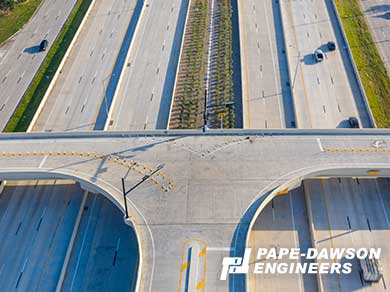Rome wasn’t built in a day. In fact, if Rome was built in modern times much of the building process might not even take place in the city.
Today, improvements in technology and processes allow a significant portion of construction tasks to occur in a different location than the project site. Construction companies can create modules off site, bring them to the construction location, and connect them to the structure there.
A surge in off-site construction has produced significant benefits for construction firms, developers, and the public, says Corbett Freeman, P.E., Vice President at Pape-Dawson Engineers. In recent years, Corbett and his team of structural engineers have used off-site building activities to deliver projects and have seen firsthand the benefits of this approach, including:
Time “We can really compress the schedule, possibly saving months. If we can conduct parts of the construction off-site, we don’t have to wait the standard 28-day concrete curing period before we move to the next step,” says Pape-Dawson Senior Project Manager Marcos Wortley, P.E. Conducting steps simultaneously rather than sequentially means completing projects faster.
Sustainability Reusing formwork at the manufacturing facility results in less waste. “The overall volume of concrete required for structures is significantly reduced due to less clear cover requirements around the reinforcing,” Marcos adds. “Also, most manufacturing facilities produce their own concrete, which eliminates the multiple back & forth trips of concrete trucks.”
Safety Creating components in a controlled environment can be safer for both the general public and construction workers. A consistent work crew and a controlled workflow make operations more efficient and improve employee welfare, while minimizing impacts to traffic.
Ideal conditions “In a controlled environment off site, you have the right temperature, the right moisture—the ideal conditions for building things, especially out of concrete,” says Arthur Vidales, P.E., Project Manager at Pape-Dawson. Building components in a precast yard means saying goodbye to rain delays—and no more ruined on-site pours caused by concrete hardening in a traffic jam en route to the project site.
Method flexibility Concrete extrusion (a method that pushes concrete out of a machine, like toothpaste from a tube) can result in quick, quality concrete construction without formwork, but can be performed only in a precast yard, not at a construction site.
Supplies availability Fabricators typically have certain materials available and on tap for their precast needs, which can help relieve some supply chain concerns.
The use of off-site construction techniques introduces a set of new considerations, as well. For one, it may influence the design of structural components. “The stress the components experience when 18-wheelers transport them to the field or cranes lift them into place can be large enough that we have to account for it in the design,” says Arthur.
Engineers must plan space at the construction site differently, too. Cranes that place those components require a large, open area to maneuver. When individual components are brought from another location, they are offloaded to a nearby staging area. Tight construction spaces may deny an opportunity to use prefabricated elements. “Some of the bridge replacements we’ve been doing recently are in super-rural areas with very tight right-of-way space,” says Marcos. “A place like that doesn’t invite prefabrication because you don’t have anywhere to set these pieces down when they’re delivered.” Corbett agrees: “I’ve been on projects where the whole bridge was cast in place because we physically didn’t have any other option, space-wise.”
Although timeline benefits arise from off-site fabrication, the practice still requires careful synchronization. “Precasting things can help in the supply chain and overall schedule, but the timing still has to work out,” Corbett warns. A delay on the supplier’s or fabricator’s end can still result in a delay for the project.
Components built off site can contribute to quick bridge replacements, pedestrian bridges, multilevel interchanges, retaining walls, wastewater treatment plants, industrial plants, architectural construction, and underground structures such as junction boxes, lift stations, and pump stations. For any of those, says Corbett, “We go in with the mindset that we’ll try to prefabricate everything possible, but then we scale back for those things that just don’t make sense… those things that are too cumbersome, too expensive, or just not feasible.” At the start of a project, his team talks with vendors about what segments would be best constructed off site. “Even at the concept stage, it’s really valuable to have close industry contacts who can give us insight into what worked well in the past.”
In the end, huge benefits can come from building components of a structure off site—whether that takes place in Rome, the U.S., or anywhere else in the world.
Download the article here: Off-Site Construction: Why the Next Bridge You Cross Might Not Have Been Built There
